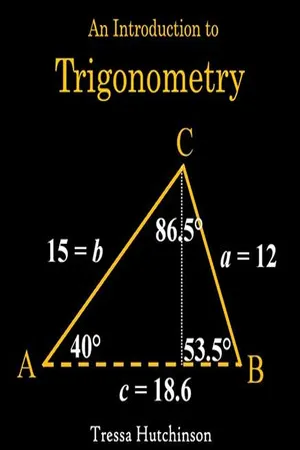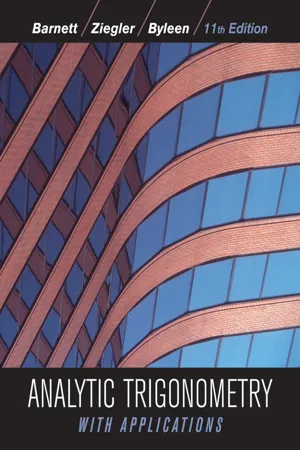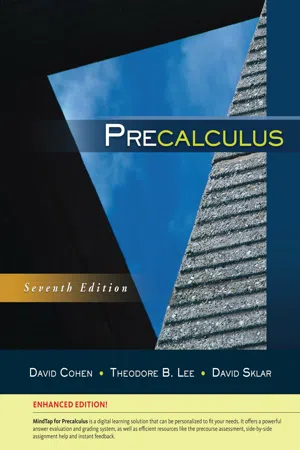Mathematics
Law of Sines in Algebra
The Law of Sines in algebra is a trigonometric principle used to solve triangles. It states that the ratio of the length of a side of a triangle to the sine of its opposite angle is constant for all three sides and angles. This law is particularly useful for finding missing side lengths or angles in non-right-angled triangles.
Written by Perlego with AI-assistance
Related key terms
1 of 5
12 Key excerpts on "Law of Sines in Algebra"
- No longer available |Learn more
- (Author)
- 2014(Publication Date)
- Learning Press(Publisher)
________________________ WORLD TECHNOLOGIES ________________________ Chapter 5 Common Laws & Formulas in Trigonometry 1. Law of sines A triangle In trigonometry, the law of sines (also known as the sine law , sine formula , or sine rule ) is an equation relating the lengths of the sides of an arbitrary triangle to the sines of its angles. According to the law, where a , b , and c are the lengths of the sides of a triangle, and A , B , and C are the opposite angles (see the figure above). Sometimes the law is stated using the reciprocal of this equation: The law of sines can be used to compute the remaining sides of a triangle when two angles and a side are known—a technique known as triangulation. It can also be used when two sides and one of the non-enclosed angles are known. In some such cases, the formula gives two possible values for the enclosed angle, leading to an ambiguous case . ________________________ WORLD TECHNOLOGIES ________________________ The law of sines is one of two trigonometric equations commonly applied to find lengths and angles in a general triangle, the other being the law of cosines. Examples The following are examples of how to solve a problem using the law of sines: Given: side a = 20, side c = 24, and angle C = 40° Using the law of sines, we conclude that Or another example of how to solve a problem using the law of sines: If two sides of the triangle are equal to R and the length of the third side, the chord, is given as 100 feet and the angle C opposite the chord is given in degrees, then and Numeric problems Like the law of cosines, although the law of sines is mathematically true, it has problems for numeric use. Much precision may be lost if an arcsine is computed when the sine of an angle is close to one. ________________________ WORLD TECHNOLOGIES ________________________ Some applications • The sine law can be used to prove the angle sum identity for sine when α and β are each between 0 and 90 degrees. - eBook - PDF
Precalculus
Building Concepts and Connections 2E
- Revathi Narasimhan(Author)
- 2016(Publication Date)
- XYZ Textbooks(Publisher)
The Law of Sines relates the sines of the angles to the sides as follows. Law of Sines Let ABC be a triangle with sides a, b, c . ( See Figure 1.) Then the following ratios hold: a _____ sin A = b _____ sin B = c _____ sin C The ratios can also be written as sin A _____ a = sin B _____ b = sin C _____ c Proof of Law of Sines Case 1 : A is acute. Referring to Figure 2, we have sin A = h __ b ⇒ h = b sin A sin B = h __ a ⇒ h = a sin B Equating these two expressions for h , we find that b sin A = a sin B Dividing by (sin A )(sin B ), we have b _____ sin B = a _____ sin A (1) Note that sin A and sin B are both always nonzero, because the angles of a triangle are greater than 0 ° and less than 180 ° . Next, referring to Figure 2, we have sin B = h ′ __ c ; sin C = h ′ __ b Solving each of these equations for hʹ and then equating the two expressions for hʹ gives c sin B = b sin C ⇒ c _____ sin C = b _____ sin B Combining this result with Equation (1) gives a _____ sin A = b _____ sin B = c _____ sin C Case 2 : A is obtuse. Referring to Figure 3, we have sin(180 ° − A ) = h __ b sin B = h __ a A B C b a c Figure 1 Note You can use the ratios in either form when solving a triangle, as long as you are consistent. b a c h h 9 C A B Figure 2 C A B a b c h h 9 Figure 3 The Law of Sines Objectives ■ Solve an oblique triangle using the Law of Sines. ■ Solve applied problems using the Law of Sines. 556 Chapter 7 Additional Topics in Trigonometry Using the difference identity for sine, sin(180 0 − A ) = sin A . Thus, sin A = h __ b ; sin B = h __ a Following the same procedure as in Case 1 gives: b _____ sin B = a _____ sin A Continue just as in Case 1 after Equation (1) to obtain a _____ sin A = b _____ sin B = c _____ sin C You can use the Law of Sines to solve an oblique triangle when you are given the following information about the angles and sides. ■ ASA: A side is common to the two angles (Figure 4). ■ AAS: A side is opposite to one of the angles (Figure 5). - eBook - PDF
- Raymond A. Barnett, Michael R. Ziegler, Karl E. Byleen(Authors)
- 2012(Publication Date)
- Wiley(Publisher)
6.1 Law of Sines 351 TABLE 1 Significant digits Angle to nearest for side measure 1° 2 or 0.1° 3 or 0.01° 4 or 0.001° 5 10– 1 ¿ 10¿ When you solve for a particular side or angle, you should always carry out all operations within the calculator and then round to the appropriate number of sig- nificant digits (following the rules in Table 1) at the very end of the calculation. Note that your answers still may differ slightly from those in the book, depending on the order in which you solve for the sides and angles. ■ ■ Deriving the Law of Sines The law of sines is relatively easy to derive using the right triangle properties we studied earlier. We also use the fact that which can be obtained from the difference identity for sine. Referring to the tri- angles in Figure 2, we will proceed as follows: For each triangle, and Therefore, and h = a sin b h = b sin a sin b = h a sin a = h b sin(180° - x) = sin x Remark on Calculations a a m b b h g b a a m h g b c c 180 g (a) Acute triangle (b) Obtuse triangle FIGURE 2 Since b sin a and a sin b are both equal to h, and (1) Similarly, for each triangle in Figure 2, and Therefore, and Since c sin a and a sin g are both equal to m, and (2) If we combine equations (1) and (2), we obtain the law of sines. sin a a = sin g c c sin a = a sin g m = a sin g m = c sin a = m a sin g = sin(180° - g) sin a = m c sin a a = sin b b b sin a = a sin b 352 6 ADDITIONAL TOPICS: TRIANGLES AND VECTORS In words, in any triangle the ratio of the sine of an angle to its opposite side is the same as the ratio of the sine of either of the other angles to its opposite side. sin a a = sin b b = sin g c LAW OF SINES c a b b a g The law of sines is used to solve triangles, given: 1. Two angles and any side (ASA or AAS), or 2. Two sides and an angle opposite one of them (SSA) We will apply the law of sines to the easier ASA and AAS cases first; then we will turn to the more difficult SSA case. - eBook - PDF
- Sheldon Axler(Author)
- 2011(Publication Date)
- Wiley(Publisher)
section 10.4 The Law of Sines and the Law of Cosines 631 The Law of Cosines The law of sines is a wonderful tool for finding the lengths of all three sides of a triangle when we know two of the angles of the triangle (which means that we know all three angles) and the length of at least one side of the triangle. Also, if we know the lengths of two sides of a triangle and one of the angles other than the angle between those two sides, then the law of sines allows us to find the other angles and the length of the other side, although it may produce two possible choices rather than a unique solution. However, the law of sines is of no use if we know the lengths of all three sides of a triangle and want to find the angles of the triangle. Similarly, the law of sines cannot help us if the only information we know about a triangle is the length of two sides and the angle between those sides. Fortunately the law of cosines, our next topic, provides the necessary tools for these tasks. As we will see, the law of cosines is a general- ization to all triangles of the Pythagorean Theorem, which ap- plies only to right tri- angles. Consider a triangle with sides of lengths a, b, and c and an angle of C opposite the side of length c, as shown here. C a b c t r h Drop a perpendicular line segment from the vertex opposite the side of length b to the side of length b, as shown above. The length of this line segment is the height of the triangle; label it h. The endpoint of this line segment of length h divides the side of the triangle of length b into two smaller line segments, which we have labeled r and t above. The line segment of length h shown above divides the original larger triangle into two smaller right triangles. Looking at the right triangle on the right, we see that sin C = h a . Thus h = a sin C. Furthermore, looking at the same right triangle, we see that cos C = t a . Thus t = a cos C. The figure above also shows that r = b - t . - eBook - PDF
Precalculus
A Prelude to Calculus
- Sheldon Axler(Author)
- 2016(Publication Date)
- Wiley(Publisher)
The law of sines and law of cosines could have been called the sine theorem and cosine theorem. cosines could be used, as discussed below: • Suppose you know only the lengths of all three sides of a triangle. The only possibility in this situation is first to use the law of cosines to find one of the angles. Then, knowing the lengths of all three sides of the triangle and one angle, you could use either the law of cosines or the law of sines to find another angle. However, the law of sines may lead to two choices for the angle rather than a unique choice; thus it is better to use the law of cosines in this situation. • Another case where you could use either law is when you know the length of two sides of a triangle and an angle other than the angle between those two sides. With the notation from the beginning of this section, suppose we know a, c, and C. We could use either the law of sines or the law of cosines to get an equation with only one unknown: sin A a = sin C c or c 2 = a 2 + b 2 - 2ab cos C. The first equation above, where A is the unknown, may lead to two possible choices for A. Similarly, the second equation above, where b is the unknown and we need to use the quadratic formula to solve for b, may lead to two possible choices for b. Thus both laws may give us two choices. The law of sines is probably a bit simpler to apply. The box below summarizes when to use which law. As usual, you will be better This illustration published in 1621 by Swiss mathematician Peter Ryff shows trigonometry being used to measure the height of a column. off understanding how these guidelines arise (you can then always reconstruct them) rather than memorizing them. If you know two angles of a triangle, then finding the third angle is easy because the sum of the angles of a triangle equals π radians or 180 ◦ . - eBook - PDF
- Ron Larson(Author)
- 2021(Publication Date)
- Cengage Learning EMEA(Publisher)
ALGEBRA HELP When using the Law of Sines, choose the form so that the unknown variable is in the numerator. One solution: a ≥ b Figure 8.3 a = 22 in. b = 12 in. A B 42° c C The Ambiguous Case (SSA) Consider a triangle in which a, b, and A are given, and h = b sin A. A is acute. A is acute. A is acute. A is acute. A is obtuse. A is obtuse. Sketch A b a h a h b A A a b h a a h b A a b A a b A Necessary a < h a = h a ≥ b h < a < b a ≤ b a > b condition Triangles None One One Two None One possible Copyright 2022 Cengage Learning. All Rights Reserved. May not be copied, scanned, or duplicated, in whole or in part. Due to electronic rights, some third party content may be suppressed from the eBook and/or eChapter(s). Editorial review has deemed that any suppressed content does not materially affect the overall learning experience. Cengage Learning reserves the right to remove additional content at any time if subsequent rights restrictions require it. 8.1 Law of Sines 563 GO DIGITAL EXAMPLE 4 No-Solution Case—SSA Show that there is no triangle for which a = 15, b = 25, and A = 85°. Solution Begin by making the sketch shown in Figure 8.4. From this figure, it appears that no triangle is possible. Verify this using the Law of Sines. sin B b = sin A a Reciprocal form sin B = b ( sin A a ) Multiply each side by b. sin B = 25 ( sin 85° 15 ) ≈ 1.6603 > 1 This contradicts the fact that ∣ sin B ∣ ≤ 1. So, no triangle can be formed with sides a = 15 and b = 25 and angle A = 85°. Checkpoint Audio-video solution in English & Spanish at LarsonPrecalculus.com Show that there is no triangle for which a = 4, b = 14, and A = 60°. EXAMPLE 5 Two-Solution Case—SSA Find two triangles for which a = 12 meters, b = 31 meters, and A = 20.5°. Solution Because h = b sin A = 31(sin 20.5°) ≈ 10.86 meters and h < a < b, there are two possible triangles. - eBook - PDF
- Ron Larson(Author)
- 2021(Publication Date)
- Cengage Learning EMEA(Publisher)
ALGEBRA HELP When using the Law of Sines, choose the form so that the unknown variable is in the numerator. One solution: a ≥ b Figure 6.3 a = 22 in. b = 12 in. A B 42° c C The Ambiguous Case (SSA) Consider a triangle in which a, b, and A are given, and h = b sin A. A is acute. A is acute. A is acute. A is acute. A is obtuse. A is obtuse. Sketch A b a h a h b A A a b h a a h b A a b A a b A Necessary a < h a = h a ≥ b h < a < b a ≤ b a > b condition Triangles None One One Two None One possible Copyright 2022 Cengage Learning. All Rights Reserved. May not be copied, scanned, or duplicated, in whole or in part. Due to electronic rights, some third party content may be suppressed from the eBook and/or eChapter(s). Editorial review has deemed that any suppressed content does not materially affect the overall learning experience. Cengage Learning reserves the right to remove additional content at any time if subsequent rights restrictions require it. 6.1 Law of Sines 403 GO DIGITAL EXAMPLE 4 No-Solution Case—SSA Show that there is no triangle for which a = 15, b = 25, and A = 85°. Solution Begin by making the sketch shown in Figure 6.4. From this figure, it appears that no triangle is possible. Verify this using the Law of Sines. sin B b = sin A a Reciprocal form sin B = b ( sin A a ) Multiply each side by b. sin B = 25 ( sin 85° 15 ) ≈ 1.6603 > 1 This contradicts the fact that ∣ sin B ∣ ≤ 1. So, no triangle can be formed with sides a = 15 and b = 25 and angle A = 85°. Checkpoint Audio-video solution in English & Spanish at LarsonPrecalculus.com Show that there is no triangle for which a = 4, b = 14, and A = 60°. EXAMPLE 5 Two-Solution Case—SSA Find two triangles for which a = 12 meters, b = 31 meters, and A = 20.5°. Solution Because h = b sin A = 31(sin 20.5°) ≈ 10.86 meters and h < a < b, there are two possible triangles. - eBook - PDF
- Cynthia Y. Young(Author)
- 2021(Publication Date)
- Wiley(Publisher)
We choose the smaller angle first to avoid the ambiguity with the Law of Sines. Alternatively, if we wanted to solve for the obtuse angle first, we could have used the Law of Cosines to solve for α. STUDY TIP Although the Law of Sines can sometimes lead to the ambiguous case, the Law of Cosines never leads to the ambiguous case. EXAMPLE 2 Using the Law of Cosines in an Application (SAS) In an AKC (American Kennel Club)-sanctioned field trial, a judge sets up a mark (bird) that requires the dog to swim across a body of water (the dogs are judged on how closely they adhere to the straight line to the bird, not the time it takes to retrieve the bird). The judge is trying to calculate how far the dog would have to swim to this mark, so she walks off the two legs across the land and measures the angle as shown in the figure. How far will the dog swim from the starting line to the bird? Solution Label the triangle. Use the Law of Cosines. c 2 = a 2 + b 2 − 2ab cos γ Let a = 176, b = 152, and γ = 117°. c 2 = 176 2 + 152 2 − 2(176)(152) cos 117° Use a calculator to approximate the right side. c 2 ≈ 78370.3077 Solve for c and round to the nearest yard (three significant digits). c ≈ 280 yd 152 yd Pond 176 yd 117º b = 152 yd Pond a = 176 yd = 117º c 8.2 The Law of Cosines 793 Case 4: Solving Oblique Triangles (SSS) We now solve oblique triangles when all three side lengths are given (the SSS case). In this case, start by finding the measure of the largest angle (opposite the longest side) using the Law of Cosines. Then use the Law of Sines to find either of the remaining two angle measures. Finally, find the third angle measure using the fact that the three angles in a triangle always sum to 180°. Video EXAMPLE 3 Using the Law of Cosines to Solve a Triangle (SSS) Solve the triangle a = 8, b = 6, and c = 7. Solution STEP 1 Identify the largest angle, which is α. Use the Law of Cosines that involves α. a 2 = b 2 + c 2 − 2bc cos α Let a = 8, b = 6, and c = 7. - eBook - PDF
- Cynthia Y. Young(Author)
- 2021(Publication Date)
- Wiley(Publisher)
7.3.1 Conceptual Understand how to derive a formula for the area of a triangle (SAS case) using the Law of Sines. We now can use the general formula for the area of a triangle and the Law of Sines to develop a formula for the area of a triangle when the length of two sides and the measure of the angle between them are given. Words Math Start with an acute triangle (given b, c, and α). Words Math Write the sine ratio for angle α. sin α = h __ c Solve for h. h = c sin α Write the formula for area of a triangle. A triangle = 1 __ 2 bh For the SAS case, substitute h = c sin α. A SAS = 1 __ 2 bc sin α Now, the area of this triangle can be calculated with the given information (two sides and the angle between them: b, c, and α). Similarly, it can be shown that the other formulas for SAS triangles are A SAS = 1 __ 2 ab sin γ and A SAS = 1 __ 2 ac sin β h c b STUDY TIP If the triangle given is not an SAS or SSS case, then the Law of Sines or Law of Cosines can be used to determine the side length and/or angle needed to use either of the two area formulas derived in this section. 368 CHAPTER 7 Applications of Trigonometry: Triangles and Vectors Concept Check TRUE OR FALSE The area of a triangle in the SAS case is found by dividing an oblique triangle into two right triangles and applying the Law of Sines. Answer: True The Area of a Triangle (SAS) For any triangle where two sides and the angle between them are known, the area for that triangle is given by one of the following formulas (depending on which angle and sides are given): A SAS = 1 _ 2 bc sin α when b, c, and α are known. A SAS = 1 _ 2 ab sin γ when a, b, and γ are known. A SAS = 1 _ 2 ac sin β when a, c, and β are known. In other words, the area of a triangle equals one-half the product of two of its side lengths and the sine of the angle between them. Video EXAMPLE 1 Finding the Area of a Triangle (SAS Case) Find the area of the triangle a = 7.0 feet, b = 9.3 feet, and γ = 86°. - eBook - PDF
- David Cohen, Theodore Lee, David Sklar, , David Cohen, Theodore Lee, David Sklar(Authors)
- 2016(Publication Date)
- Cengage Learning EMEA(Publisher)
663 10.1 Right-Triangle Applications 10.2 The Law of Sines and the Law of Cosines 10.3 Vectors in the Plane: A Geometric Approach 10.4 Vectors in the Plane: An Algebraic Approach 10.5 Parametric Equations 10.6 Introduction to Polar Coordinates 10.7 Curves in Polar Coordinates 10.8 DeMoivre’s Theorem The subject of trigonometry is an excellent example of a branch of mathematics . . . which was motivated by both practical and intellectual interests—surveying, map-making, and navigation on the one hand, and curiosity about the size of the universe on the other. With it the Alexandrian mathe-maticians triangulated the universe and rendered precise their knowledge about the Earth and the heavens. —Morris Klein in Mathematics in Western Culture (New York: Oxford University Press, 1953) This is our fifth and final chapter on trigonometry. Some of the subject matter here takes us back to the historical roots of the subject: the study of the relationships between the sides and angles of a triangle. In Section 10.1 we look at some applica-tions of right-triangle trigonometry that we didn’t do in Chapters 6 and 7. Section 10.2 presents the law of sines and the law of cosines. These relate the angles and lengths of the sides of arbitrary triangles. In Sections 10.3 and 10.4 we introduce the impor-tant topic of vectors, first from a geometric standpoint and then from an algebraic standpoint. In Sections 10.5 through 10.7 we expand upon some of the ideas in Chapters 1 and 3 on graphs, and equations, as we look at parametric equations and polar coordinates. Section 10.8 uses trigonometric identities and polar coordinates to present DeMoivre’s theorem, which we use to find the n distinct n th roots of a complex number. CHAPTER 10 Additional Topics in Trigonometry 10.1 RIGHT-TRIANGLE APPLICATIONS* We continue the work we began in Section 7.5 on right-triangle trigonometry. - eBook - PDF
- Cynthia Y. Young(Author)
- 2017(Publication Date)
- Wiley(Publisher)
63. The Pythagorean theorem is a special case of the Law of Cosines. 64. The Law of Cosines is a special case of the Pythagorean theorem. 65. In a triangle, the length of the shortest side of the triangle is 1 2 the length of the longest side. The other side of the triangle is 3 4 the length of the longest side. What is the size of the largest angle? 66. In a triangle, the length of one side is 1 4 the length of an adjacent side. If the angle between the sides is 60°, how does the length of the third side compare with that of the longer of the other two? 67. Show that cos a a 1 cos b b 1 cos g c 5 a 2 1 b 2 1 c 2 2 abc . Hint: Use the Law of Cosines. 68. Show that a 5 c cos b 1 b cos g. Hint: Use the Law of Cosines. 69. In an isosceles triangle, the longer side is 50% longer than the other two sides. What is the size of the vertex angle? 70. In an isosceles triangle, the longer side is 2 inches longer than the other two sides. If the vertex angle measures 80°, what are the lengths of the sides? • C H A L L E N G E • T E C H N O L O G Y For Exercises 71–74, let A, B, and C be the lengths of the three sides with X, Y, and Z as the corresponding angle measures. Write a program using the TI calculator to solve the given triangle. A B C X Z Y 71. B 5 45, C 5 57, and X 5 43° 72. B 5 24.5, C 5 31.6, and X 5 81.5° 73. A 5 29.8, B 5 37.6, and C 5 53.2 74. A 5 100, B 5 170, and C 5 250 SKILLS OBJECTIVES ■ ■ Find the area of a triangle in the SAS case. ■ ■ Find the area of a triangle in the SSS case. CONCEPTUAL OBJECTIVES ■ ■ Understand how to derive a formula for the area of a triangle (SAS case) using the Law of Sines. ■ ■ Understand how to derive a formula for the area of a triangle (SSS case) using the Law of Cosines. 7.3 THE AREA OF A TRIANGLE In Sections 7.1 and 7.2, we used the Law of Sines and the Law of Cosines to solve oblique triangles, which means to find all of the side lengths and angle measures. - eBook - PDF
- Ron Larson(Author)
- 2017(Publication Date)
- Cengage Learning EMEA(Publisher)
Is the result the same as when the Law of Sines is used to solve the triangle? Describe the advantages and the disadvantages of each method. 65. Writing In Exercise 64, the Law of Cosines was used to solve a triangle in the two-solution case of SSA. Can the Law of Cosines be used to solve the no-solution and single-solution cases of SSA? Explain. 66. HOW DO YOU SEE IT? To solve the triangle, would you begin by using the Law of Sines or the Law of Cosines? Explain. (a) A B a = 12 b = 16 c = 18 C (b) A B a = 18 b c C 35° 55° 67. Proof Use the Law of Cosines to prove each identity. (a) 1 2 bc(1 + cos A) = a + b + c 2 uni2219 -a + b + c 2 (b) 1 2 bc(1 - cos A) = a - b + c 2 uni2219 a + b - c 2 An engine has a seven-inch connecting rod fastened to a crank (see figure). 7 in. 1.5 in. x θ (a) Use the Law of Cosines to write an equation giving the relationship between x and θ . (b) Write x as a function of θ . (Select the sign that yields positive values of x.) (c) Use a graphing utility to graph the function in part (b). (d) Use the graph in part (c) to determine the total distance the piston moves in one cycle. 56. Mechanical Engineering Smart-foto/Shutterstock.com Copyright 2018 Cengage Learning. All Rights Reserved. May not be copied, scanned, or duplicated, in whole or in part. Due to electronic rights, some third party content may be suppressed from the eBook and/or eChapter(s). Editorial review has deemed that any suppressed content does not materially affect the overall learning experience. Cengage Learning reserves the right to remove additional content at any time if subsequent rights restrictions require it. 3.3 Vectors in the Plane 278 Chapter 3 Additional Topics in Trigonometry Represent vectors as directed line segments. Write component forms of vectors. Perform basic vector operations and represent vector operations graphically. Write vectors as linear combinations of unit vectors.
Index pages curate the most relevant extracts from our library of academic textbooks. They’ve been created using an in-house natural language model (NLM), each adding context and meaning to key research topics.











